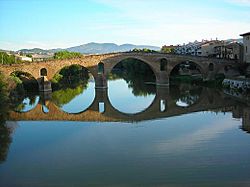Arga (river) facts for kids
Quick facts for kids Arga |
|
|---|---|

Bridge (early 11th century) over the Arga river at Puente La Reina
|
|
| Other name(s) | (Runa) |
| Country | Spain |
| Region | Navarre |
| City | Pamplona |
| Physical characteristics | |
| Main source | near Esteríbar |
| River mouth | Aragón River 42°17′48″N 1°47′7″W / 42.29667°N 1.78528°W |
| Length | 145 km (90 mi) |
| Basin features | |
| Progression | Ebro→ Mediterranean Sea |
The Arga River is a river in Navarre, Spain. It's a branch, or tributary, of the Aragón River, which then flows into the larger Ebro River. Long ago, people knew the Arga River as the Runa.
This river is located in the northeast part of Spain. It flows for about 145 kilometers (90 miles). The area of land that drains into the Arga River, called its basin, covers about 2,759 square kilometers (1,065 square miles). Most of this basin is in Navarre, with a small part in the province of Alava.
The Arga River starts near the village of Esteríbar, close to the border with France. It then travels until it joins the Aragón River near Funes. There's a dam on the river at the Eugui reservoir near Esteríbar. This dam is very important because it helps supply water to Pamplona, the biggest city along the Arga River.
Plants Along the Arga River
The types of plants and trees you see along the Arga River change as you move from its beginning to its end.
Upper River Area
Near where the river starts, in the upper part of its basin, you'll mostly find beech trees. Underneath these tall trees, smaller plants like bilberries, Cornish heath, and different kinds of sedges and luzulas grow.
Around the Eugui reservoir, you can spot various shrubs and smaller trees. These include alder, ash, maple, common hazel, and buckthorn.
Lower River Area
After the dam, as the river flows further, the plants change. Here, you'll see more oak trees and Scots pine trees. You might also find boxwood shrubs.
When the river passes by Huarte/Uharte, a type of tree called a crack willow starts to appear. As the river reaches the area around Belascoáin, the plant life changes again. It shifts from the types of forests found in Cantabria to plants more common in Mediterranean climates. In this region, black poplar and white willow trees are very common along the riverbanks.
See also
 In Spanish: Río Arga para niños
In Spanish: Río Arga para niños

